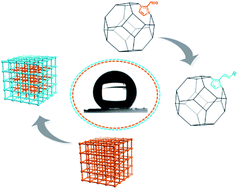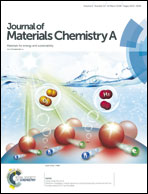Fine-tuning metal–organic framework performances by spatially-differentiated postsynthetic modification†
Abstract
In contrast to the regular postsynthetic modification (PSM) approach which is global and random in principle, a diffusion-controlled PSM strategy utilizing size mismatch between pores and reactants has been developed to target selective functionalization and fine-tuning of material performance. Demonstrating through narrow-pore ZIF-90 reacting with amines of contrasting aliphatic chain lengths, we manage to regulate the extent and distribution of hydrophobic functionalization, and to judiciously tune the hydrophobicity of the crystalline materials. A subtle balance between reagent dose, water tolerance enhancement, and maintenance of gas adsorption performance has been achieved. ZIF-90 crystallites are imparted with surface hydrophobicity by only 1% aliphatic modification of ligands, while its hydrothermal stability is enhanced by 5% aliphatic modification, owing to the coverage of the vulnerable mesopore regions in the overall structure. Moreover, such low-dose PSM avoids severe pore blockage which would result in significant repellence of gas/vapor adsorbates (e.g. N2, CO2, H2O), as also predicted by ideal adsorbed solution theory (IAST), showing largely unaffected CO2/N2 and CO2/CH4 separation performance. This proposed spatially-differentiated strategy provides a facile route to implementing diffusion-limited PSM processes to fabricate core–shell-like MOFs.



 Please wait while we load your content...
Please wait while we load your content...